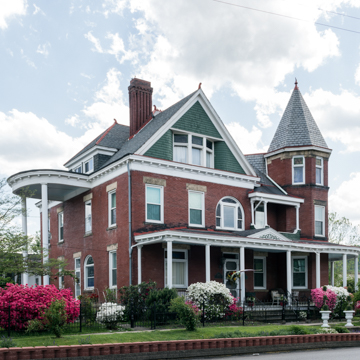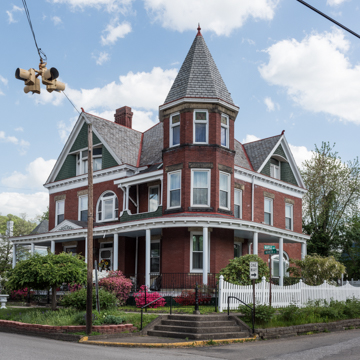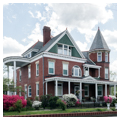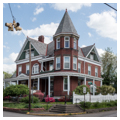After the railroad arrived in 1884, North Street, northernmost of the town's original east-west streets, became the main thoroughfare from Main Street to the depot. Commercial, residential, and fraternal structures soon lined the street, in no discernible order or arrangement. The c. 1890 house at 201 North Street (southeast corner of North and Maple streets) is a textbook Queen Anne brick house, complete with octagonal corner tower, wrap-around porch, and pedimented gables protruding from an expansive hipped roof. The New Martinsville Grocery Company (c. 1900), across the street at the northeast corner of North and Maple streets, is a large three-story brick warehouse and office. Most of its architectural ornamentation is at the top, where a pedimented gable interrupts a full entablature at the center of each side. The James P. Chaplin House, home of New Martinsville's resident turn-ofthe-century architect and builder, stands nearby at the northeast corner of North Street and Poplar Lane. A two-story American Foursquare frame house, it has corner pilasters of the Ionic order and curious gambrel-roofed dormers protruding from its hipped roof. Next door is the A. C. Ruby House (c. 1890), a Queen Anne house identifiable by a gargantuan three-story polygonal tower.
You are here
North Street
If SAH Archipedia has been useful to you, please consider supporting it.
SAH Archipedia tells the story of the United States through its buildings, landscapes, and cities. This freely available resource empowers the public with authoritative knowledge that deepens their understanding and appreciation of the built environment. But the Society of Architectural Historians, which created SAH Archipedia with University of Virginia Press, needs your support to maintain the high-caliber research, writing, photography, cartography, editing, design, and programming that make SAH Archipedia a trusted online resource available to all who value the history of place, heritage tourism, and learning.




